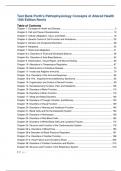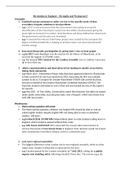Exam (elaborations)
Test Bank Porth's Pathophysiology Concepts of Altered Health 10th Edition Norris
- Course
- Institution
Test Bank Porth's Pathophysiology Concepts of Altered Health 10th Edition Norris Table of Contents Chapter 1- Concepts of Health and Disease ...................................................................................... 3 Chapter 2- Cell and Tissue Characteristics ............................
[Show more]




